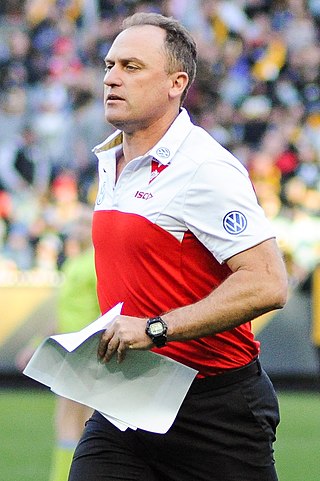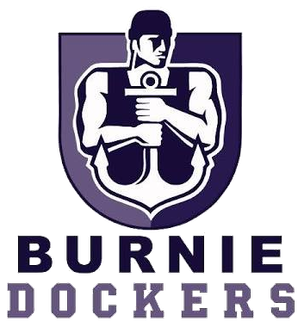Related Research Articles

The Essendon Football Club, nicknamed the Bombers, is a professional Australian rules football club. The club plays in the Australian Football League (AFL), the game's premier competition. The club was formed by the McCracken family in their Ascot Vale home "Alisa", and while the exact date is unknown, it is generally accepted to have been in 1872. The club's first recorded game took place on 7 June 1873 against a Carlton Second 20. From 1878 until 1896, the club played in the Victorian Football Association, then joined seven other clubs in October 1896 to form the breakaway Victorian Football League. Headquartered at the Essendon Recreation Ground, known as Windy Hill, from 1922 to 2013, the club moved to The Hangar in near Tullamarine in late 2013 on land owned by the Melbourne Airport. The club currently plays its home games at either Docklands Stadium or the Melbourne Cricket Ground. Zach Merrett is the current club captain.
Peter John HudsonAM is a former Australian rules footballer who played for the Hawthorn Football Club in the Victorian Football League (VFL) and for the New Norfolk Football Club and Glenorchy Football Club in the Tasmanian Australian National Football League (TANFL).

John Longmire is the current coach of the Sydney Swans in the Australian Football League (AFL) since 2010, and is the longest serving active AFL coach. As a player, he represented the North Melbourne Football Club in the Australian Football League (AFL) from 1988 to 1999.
Shannon Grant is a former Australian rules footballer who was a midfielder in the AFL. He began his career at the Sydney Swans in 1995 before moving to the Kangaroos in 1998 and being a part of their 1999 premiership side, in which he also won the Norm Smith Medal for best on ground. In 1996, he actually played against North Melbourne in the Grand Final, playing on the losing side of Sydney.

The AFL Grand Final is an Australian rules football match to determine the premiers for the Australian Football League (AFL) season. From its inception until 1989, it was known as the VFL Grand Final, as the league at that time was the Victorian Football League. Played at the end of the finals series, the game has been held annually since 1898, except in 1924. It is traditionally staged on the afternoon of the last Saturday in September, at the Melbourne Cricket Ground.
Hayden Skipworth is a former Australian rules footballer who played in the Australian Football League (AFL) with the Adelaide Football Club and the Essendon Football Club. Skipworth returned to the Essendon Football Club, where he served as the midfield coach until the conclusion of the 2019 Season. In the 2020 Season, Skipworth served as the Collingwood Football Club's Head of Academy before moving into a Line Coach position at the club in October 2020.
Gavin Brown is a former Australian rules footballer who represented Collingwood in the Australian Football League (AFL) during the 1980s and 1990s. Since retiring as a player he has been an assistant coach with Collingwood, Carlton and joined North Melbourne at the end of the 2013 season. He is currently serving as a development coach at North Melbourne.
Bradley David Walter Scott is a former Australian rules footballer who is currently the coach of the Essendon Football Club in the Australian Football League (AFL). He played for Hawthorn and the Brisbane Lions, and was previously the coach of the North Melbourne Football Club from 2010 until 2019.
Rivalries in the Australian Football League exist between many teams, most of which typically draw large crowds and interest regardless of both teams' positions on the ladder. The AFL encourages the building of such rivalries, as a method of increasing publicity for the league, to the point of designating one round each year as "Rivalry Round" when many of these match-ups are held on the one weekend. Whilst some rivalries, such as between teams from adjacent areas, are still strong, the designation of an entire round of fixtures as a Rivalry Round is often criticised due to some arbitrary match-ups, or ignoring stronger and more recent rivalries.
The 1993 AFL season was the 97th season of the Australian Football League (AFL), the highest level senior Australian rules football competition in Australia, which was known as the Victorian Football League until 1989. The season featured fifteen clubs, ran from 26 March until 25 September, and comprised a 20-game home-and-away season followed by a finals series featuring the top six clubs.
The 1952 VFL season was the 56th season of the Victorian Football League (VFL), the highest level senior Australian rules football competition in Victoria. The season featured twelve clubs, ran from 19 April until 27 September, and comprised a 19-game home-and-away season followed by a finals series featuring the top four clubs.
The 1965 VFL season was the 69th season of the Victorian Football League (VFL), the highest level senior Australian rules football competition in Victoria. The season featured twelve clubs, ran from 17 April until 25 September, and comprised an 18-game home-and-away season followed by a finals series featuring the top four clubs.
The 1972 VFL season was the 76th season of the Victorian Football League (VFL), the highest level senior Australian rules football competition in Victoria. The season featured twelve clubs, ran from 1 April until 7 October, and comprised a 22-game home-and-away season followed by a finals series featuring the top five clubs – an increase from the four clubs which had contested the finals in previous years.
The 1974 VFL season was the 78th season of the Victorian Football League (VFL), the highest level senior Australian rules football competition in Victoria. The season featured twelve clubs, ran from 6 April until 28 September, and comprised a 22-game home-and-away season followed by a finals series featuring the top five clubs.

Burnie Dockers Football Club is an Australian rules football club in Burnie, Tasmania, Australia. The club currently competes in the North West Football League (NWFL).

The Hawthorn Football Club, nicknamed the Hawks, is a professional Australian rules football club based in Mulgrave, Victoria, that competes in the Australian Football League (AFL). The club was founded in 1902 in the inner-east suburb of Hawthorn, making it the youngest Victorian-based team in the AFL.
Wayne "Baldy" Fox is a former Australian rules footballer who played for various clubs in the Tasmanian Australian National Football League (TANFL) and later, the TFL Statewide League. He also played with Footscray in the Victorian Football League (VFL).
The AFL Australian Football League is the top professional Australian rules football league in the world. The league consists of eighteen teams: nine based in the city of Melbourne, one from regional Victoria, and eight based in other Australian states. The reason for this unbalanced geographic distribution lies in the history of the league, which was based solely within Victoria from the time it was established in 1897, until the time the league expanded through the addition of clubs from interstate to the existing teams starting in the 1980s; until this expansion, the league was known as the VFL (Victorian Football League).
Gareth John is a former Australian rules footballer who played with the Sydney Swans and North Melbourne in the Australian Football League (AFL).
The history of the Geelong Football Club, began in 1859 in the city of Geelong, Australia, is significant as the club is the second oldest AFL club, is believed to be the fourth oldest football club in Australia and one of the oldest in the world and one of the most successful. Initially playing under its own rules, some of which, notably, were permanently introduced into Australian Football. It adopted the Laws of Australian Football in the early 1860s after a series of compromises with the Melbourne Football Club.
References
- Bradley Plain's playing statistics from AFL Tables
- Holmesby, Russell and Main, Jim (2007). The Encyclopedia of AFL Footballers. 7th ed. Melbourne: Bas Publishing.